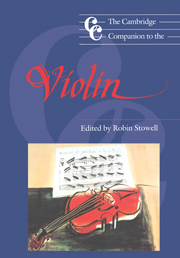Book contents
- Frontmatter
- 1 The violin and bow – origins and development
- 2 The physics of the violin
- 3 The violinists of the Baroque and Classical periods
- 4 The nineteenth-century bravura tradition
- 5 The twentieth century
- 6 The fundamentals of violin playing and teaching
- 7 Technique and performing practice
- 8 Aspects of contemporary technique (with comments about Cage, Feldman, Scelsi and Babbitt)
- 9 The concerto
- 10 The sonata
- 11 Other solo repertory
- 12 The violin as ensemble instrument
- 13 The pedagogical literature
- 14 The violin – instrument of four continents
- 15 The violin in jazz
- Appendix Principal violin treatises
- Glossary of technical terms
- Notes
- Select bibliography
- Index
4 - The nineteenth-century bravura tradition
Published online by Cambridge University Press: 28 September 2011
- Frontmatter
- 1 The violin and bow – origins and development
- 2 The physics of the violin
- 3 The violinists of the Baroque and Classical periods
- 4 The nineteenth-century bravura tradition
- 5 The twentieth century
- 6 The fundamentals of violin playing and teaching
- 7 Technique and performing practice
- 8 Aspects of contemporary technique (with comments about Cage, Feldman, Scelsi and Babbitt)
- 9 The concerto
- 10 The sonata
- 11 Other solo repertory
- 12 The violin as ensemble instrument
- 13 The pedagogical literature
- 14 The violin – instrument of four continents
- 15 The violin in jazz
- Appendix Principal violin treatises
- Glossary of technical terms
- Notes
- Select bibliography
- Index
Summary
At the beginning of the nineteenth century the derivative French classical school of violin playing was pre-eminent, based at the Conservatoire de Musique in Paris (established in 1795). The parent Italian violin school had largely run its course, but it was an Italian, Viotti, who had largely been responsible for laying the foundations of the highly systematised French approach to violin playing and teaching, and his methods were disseminated widely through his own performances and teaching. With the extension of the French school into Belgium in the 1840s and the influence of violinist-composers such as Spohr in Germany, the stage was set for the full flush of Romanticism to blossom in the form of the itinerant virtuoso, ‘one of the essential and corroding institutions in music history’ responsible for both the development and the debasement of the violin art.
France and Belgium
By the beginning of the nineteenth century Viotti had retired almost entirely from music in order to devote his attentions to his London wine business, the eventual failure of which left him with substantial debts; Gaviniés, Leclair's successor as leader of the French violin school, had left his legacy of distinguished pupils (e.g. Baudron, Capron, Guénin, Leduc and Paisible), some of whom had come under his wing while he was violin professor at the Paris Conservatoire; and Michel Woldemar (1750–1815) was encouraging the cultivation of more virtuosic techniques after the ‘school’ of his mentor Lolli. Although Viotti performed in public for less than ten years, the qualities of his playing dominated an entire generation of violinists. His technical brilliance, the breadth, beauty and power of his tone and the overall expressive characteristics of his performances captured the imagination of his listeners. Paul Alday, Cartier, Duranowski, Vacher, Labarre, Libon, Robberechts, F.W. Pixis and Rode were among his pupils, and both Kreutzer and Baillot have been regarded as disciples.
- Type
- Chapter
- Information
- The Cambridge Companion to the Violin , pp. 61 - 78Publisher: Cambridge University PressPrint publication year: 1992
- 1
- Cited by



